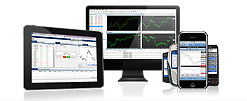What are CFDs ?
A Contract for Difference is an agreement to exchange the opening and closing price of a contract, multipied by the underlying volume of that contract.
Unlike many traditional markets, CFDs offer the added flexibility of allowing traders to go short in a comodity they do not already own.
CFDS also offer the advantage of trading on margin, which means traders only have to deposit a small percentage of the underlying values of the positions they wish to trade. This significantly increases the profit (or loss) potential. Where CFDs differ from traditional investments, such as buying equities, is that there is no physical deilvery of the underlying instrument. By buying a CFD, you are investing in teh expectation that the price of the unerlying market is going to rise; you do not actually own any of the underlying assets that the price is quoted on.
Contracts for difference are a very flexible means of trading, especialla due to the ability to 'go short' in a market.
CFD Trading Example:
An example of trading with CFDs:
You sell
10 CFDs @ 86.90 (predicting a bearish market,
meaning you expect prices to fall)
You buy
10 CFDs @ 86.84
Therefore your P/L would be…
P/L = (8690-8684) x 10
= 6 x 10
= $60
Live Account
Access a wide range of FX and CFD products through our suite of trading platforms.
Open a Live Account








